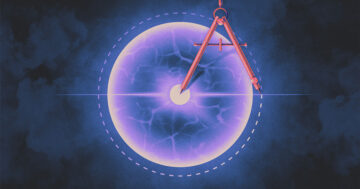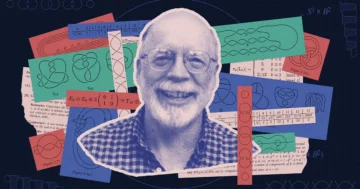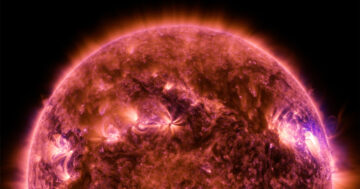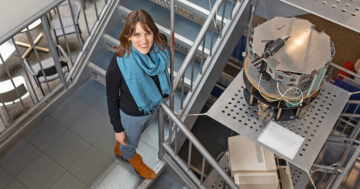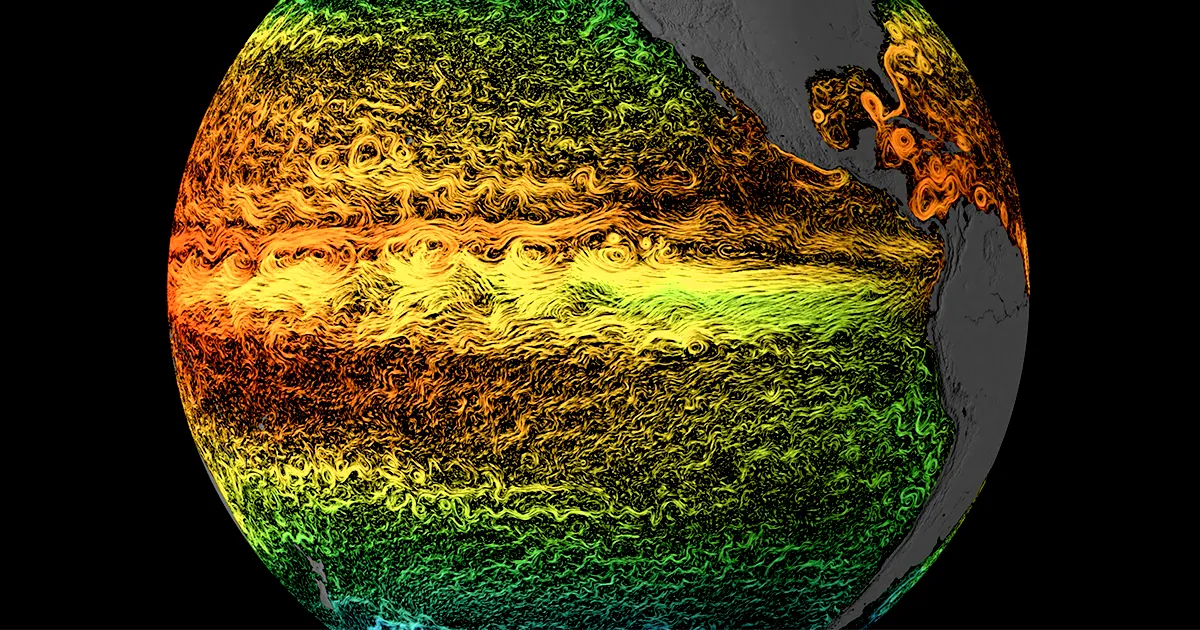
Introduction
While much of our planet’s air and seas are stirred at a tempest’s whim, some features are far more regular. At the equator, thousand-kilometer-long waves persist amid the chaos.
In both the ocean and the atmosphere, these gargantuan waves, called Kelvin waves, always travel eastward. And they fuel oscillating weather patterns such as El Niño, a periodic warming of ocean temperatures that returns every few years.
Geophysicists have leaned on a mathematical explanation for equatorial Kelvin waves since the 1960s, but for some, that explanation wasn’t entirely satisfying. These scientists wanted a more intuitive, physical explanation for the waves’ existence; they wanted to understand the phenomenon in terms of basic principles and to answer questions like: What’s so special about the equator that permits a Kelvin wave to circulate there? And “why the heck does it always travel east?” said Joseph Biello, an applied mathematician at the University of California, Davis.
In 2017, a trio of physicists applied a different type of thinking to the problem. They began by imagining our planet as a quantum system, and they ended up making an unlikely connection between meteorology and quantum physics. As it turns out, Earth’s rotation deflects the flow of fluids in a way that’s analogous to how magnetic fields twist the paths of electrons moving through quantum materials called topological insulators. If you imagine the planet as a giant topological insulator, they said, you can explain the origin of the equatorial Kelvin waves.
But even though the theory worked, it was still only theoretical. No one had directly observationally verified it. Now, in a new preprint, a team of scientists describes the direct measurement of twisting atmospheric waves — the exact kind of evidence needed to bolster the topological theory. The work has already helped scientists to use the language of topology to describe other systems, and it could lead to new insights about waves and weather patterns on Earth.
“This is a direct confirmation of these topological ideas, gleaned from actual observations,” said Brad Marston, a physicist at Brown University and an author of the new paper. “We’re actually living inside of a topological insulator.”
Geoffrey Vallis, an applied mathematician at the University of Exeter in the U.K. who was not involved in the work, said the new result is a significant advance that will provide a “foundational understanding” of Earth’s fluid systems.
The Shape of Water
There are two ways to begin this story. The first is all about water, and it starts with William Thomson, also known as Lord Kelvin. In 1879, he noticed that the tides in the English Channel were stronger along the French coastline than on the English side. Thomson realized that this observation could be explained by the Earth’s rotation. As the planet spins, it generates a force, called the Coriolis force, that causes fluids in each hemisphere to swirl in different directions: clockwise in the north, counterclockwise in the south. This phenomenon pushes the water in the English Channel up against the French shoreline, forcing waves to flow along its coast. Now known as coastal Kelvin waves, these waves have since been observed all over the world, flowing clockwise around landmasses (with the coastline on the right side of the wave) in the northern hemisphere and counterclockwise in the southern hemisphere.
Introduction
But it would be almost a century before scientists discovered the much larger equatorial ripples and connected them to the coastal Kelvin waves.
That happened in 1966, when Taroh Matsuno, a meteorologist, was mathematically modeling the behavior of fluids — both air and water — near Earth’s equator. With his calculations, Matsuno showed that Kelvin waves should also exist at the equator. In the sea, instead of pushing up against a coastline, they would collide with water from the opposite hemisphere, which rotated in the opposite direction. According to Matsuno’s mathematics, the resulting equatorial waves should flow eastward, and they should be enormous — thousands of kilometers long.
Scientists confirmed Matsuno’s predictions in 1968, when they observed the massive equatorial Kelvin waves for the first time. It was “one of the few times that [geophysical fluid] theory predated the discovery,” said George Kiladis, a meteorologist at the National Oceanic and Atmospheric Administration. Kiladis and a colleague later confirmed another of Matsuno’s predictions when they related the length of a Kelvin wave to the frequency of its wiggles — a characteristic known as a dispersion relation — and found that it matched Matsuno’s equations.
So the math worked. The equatorial waves existed, just as predicted. But Matsuno’s equations didn’t explain everything about the waves. And they weren’t enough of an explanation for everyone; just because you can solve an equation doesn’t mean you understand it. “Are you really satisfied with the ‘why’?” Biello said.
Introduction
Twists and Swirls
The why, it turned out, was hiding in the quantum realm — a place geophysicists rarely tread. Likewise, most quantum physicists don’t generally tackle the mysteries of geophysical fluids. But Marston was an exception. He began his career in condensed matter physics, but he was also curious about climate physics and the behavior of fluids in Earth’s oceans and atmosphere. Marston suspected there was a connection between geophysical waves and electrons moving through a magnetic field, but he didn’t know where to find it — until his colleague Antoine Venaille suggested looking at the equator. Marston then noticed that the dispersion relation of the waves along the equator (which Kiladis had measured) looked remarkably similar to the dispersion relation of electrons in a topological insulator. Any condensed matter physicist “would immediately recognize it,” Marston said. “If I had been paying attention to the equatorial regions of the Earth, I would have realized this much sooner.”
And here’s where the story begins for the second time, with the relatively recent discovery of the quantum behavior of electrons in topological insulators.
In 1980, a quantum physicist named Klaus von Klitzing wanted to know how electrons behaved in a magnetic field when they were chilled enough for their quantum nature to become apparent. He already knew that an electron attempting to traverse a magnetic field is deflected from its direction of motion and ends up moving in circles. But he didn’t know how that might change when he introduced the quantum component.
Von Klitzing chilled his electrons almost to absolute zero. As he suspected, at the edge of a material, the electrons only complete half their circle before running into the edge. They then migrate along that boundary, moving in a single direction. Their motion along the boundary creates an edge current. Von Klitzing found that at super-cold temperatures, when the quantum nature of electrons becomes relevant, the edge current is surprisingly robust: It’s immune to variations in the applied magnetic field, disorder in the quantum material, and any other imperfections in the experiment. He had discovered a phenomenon called the quantum Hall effect.
Over the next few years, physicists realized that the edge current’s immunity hinted at a now widely recognized concept in physics. When an object is stretched or squashed — or otherwise deformed without being broken — and its features stay the same, the object is said to be “topologically protected.” For example, if you make a Möbius strip by twisting a strip of paper once and attaching the two ends, the number of twists doesn’t change no matter how the shape is stretched. The only way to modify the twist is to cut the Möbius strip. So the strip’s winding number, 1, is a topologically protected feature.
Back to the experiment. As the electrons in the interior of von Klitzing’s super-chilled material swirled around in the magnetic field, their wave functions (a quantum description of their wavelike nature) twisted into something like a Möbius strip. By some trick of physics, the topological twists in the interior translated into an edge current that flowed without dissipating. In other words, the edge current’s immunity was a topologically protected property created by the twisting interior electrons. Materials like von Klitzing’s super-chilled samples are now referred to as topological insulators, because even though their interiors are insulators, topology allows current to flow around their edges.
When Marston and his colleagues looked at Earth’s equatorial Kelvin waves, they saw a regularity that made them wonder if the waves were analogous to the edge current in a topological insulator.
In 2017, along with Pierre Delplace and Venaille, both physicists at the École Normale Supérieure in Lyon, France, Marston observed that the Coriolis force swirls fluids on Earth the way the magnetic field spins von Klitzing’s electrons. In the planetary version of a topological insulator, equatorial Kelvin waves are like the current flowing at a quantum material’s edge. These immense waves propagate around the equator because it is the boundary between two insulators, the hemispheres. And they flow east because in the northern hemisphere, Earth’s rotation swirls fluids clockwise, and in the southern hemisphere, the ocean swirls in the other direction.
“This was the first nontrivial answer anybody provided to why the Kelvin wave should exist,” Biello said. To him, the trio had explained the phenomenon using broad, fundamental principles, rather than simply balancing terms in mathematical equations.
Venaille even thinks the topological description might explain why Earth’s equatorial Kelvin waves seem surprisingly strong, even in the face of turbulence and chaos — our planet’s erratic weather. They stand up to perturbations, he explained, in the same way that the edge current of a topological insulator flows without dissipating and with no regard for impurities in the material.
The Shape of Air
Despite the theoretical work, the connection between topological systems and Earth’s equatorial waves was still indirect. Scientists had seen the eastward-flowing waves. But they hadn’t yet seen anything analogous to the swirling interior electrons, which in a quantum system would be the original source of the boundary waves’ robustness. To confirm that on the largest scale, Earth’s fluids behave like electrons in a topological insulator, the team needed to find topologically twisted waves somewhere farther from the equator.
In 2021, Marston set out to find those twisted waves, along with Weixuan Xu, then at Brown University, and their colleagues. To do that, they looked to Earth’s atmosphere, where the Coriolis force stirs pressure waves in the same way it stirs ocean water. For their search, the team targeted a specific type of wave — called a Poincaré-gravity wave — that exists in the stratosphere, a region of the atmosphere about 10 kilometers up. (If their theory was correct, Marston said, these twisted topological waves should exist throughout the atmosphere and on the ocean’s surface. It’s just that they had the best chance of actually finding them in the relatively calm milieu of the stratosphere.)
They started by combing through the ERA5 data set from the European Center for Medium-Range Weather Forecasts, which takes atmospheric data from satellites, ground-based sensors and weather balloons and combines it with meteorological models. The team identified the Poincaré-gravity waves in those data sets. They then compared the height of the waves to the velocity of their horizontal motion. When they calculated the offset between those undulations — referred to as the phase between wave oscillations — the scientists saw that the ratio was not always the same. It depended on the exact length of the wave. When they plotted the phase in an abstract “wave vector space” — something that’s done in quantum physics all the time, but not often in earth science — they saw that the phase spiraled around and formed a vortex: The twisting in the waves’ phases resembled the spiraling wave functions in a topological insulator. Although a bit abstracted, it was the hallmark they had been searching for. “We actually proved the theory to be true,” Xu said.
Introduction
Kiladis, who was not part of the study team, said that these waves had never been analyzed in such a way before and called the study “a major breakthrough.” “My sense is that it will provide a different perspective on atmospheric waves that will likely lead to new insights,” he wrote in an email. “We need all the help we can get!”
A Topological Planet
These recent studies have opened the door for scientists to study topology in a whole host of other fluids. Previously, these materials had been out of bounds because they didn’t share a key feature with quantum materials: a periodic arrangement of atoms. “I was surprised to see that topology could be defined in fluid systems without periodic order,” said Anton Souslov, a theoretical physicist at the University of Bath in the U.K. Inspired by the 2017 paper, Souslov helped develop other tools that could be used to study topology in fluids.
Now, other scientists are looking for connections between the movements of particles at the smallest scale and the motions of fluids on planetary — or even larger — scales. Researchers are studying topology in fluids from magnetized plasmas to collections of self-propelled particles; Delplace and Venaille are wondering whether the dynamics of stellar plasma might also resemble a topological insulator. And while such insights might someday help geophysicists better predict the emergence of large-scale weather patterns on Earth, the work is already contributing to a better understanding of the role topology plays in a wide array of systems.
Last December, David Tong, a quantum theorist at the University of Cambridge, looked at the same fluid equations that Thomson had used. But this time, he considered them from a topological perspective. Tong ended up connecting the fluids on Earth to the quantum Hall effect again, but through a different approach, using the language of quantum field theory. When he tweaked the variables in the fluid flow equations, he found that those equations were equivalent to Maxwell-Chern-Simons theory, which describes how electrons move in a magnetic field. In this new view of Earth’s flow, a wave’s height corresponds to a magnetic field and its speed corresponds to an electric field. From his work, Tong was able to explain the existence of the coastal Kelvin waves that Thomson originally discovered.
Together, the ideas highlight the ubiquity of topology in our physical world, from condensed matter to the fluids flowing on Earth. “Having these kinds of parallel approaches is a great thing,” Marston said.
It’s still unclear whether, in the biggest picture, treating Earth as a topological insulator will unlock the mysteries of large-scale weather patterns, or maybe even lead to new geophysical discoveries. For now, it’s a simple reinterpretation of terrestrial phenomena. But decades ago, applying topology to condensed matter was also a reinterpretation of phenomena; von Klitzing discovered the resilience of the edge current in a quantum material, but he had no idea it had anything to do with topology. Later, other physicists reinterpreted his discovery as having a topological explanation, which ended up revealing a host of new quantum phenomena and phases of matter.
“This kind of reinterpretation,” Souslov said, “is in itself a significant advance.”
- SEO Powered Content & PR Distribution. Get Amplified Today.
- PlatoData.Network Vertical Generative Ai. Empower Yourself. Access Here.
- PlatoAiStream. Web3 Intelligence. Knowledge Amplified. Access Here.
- PlatoESG. Automotive / EVs, Carbon, CleanTech, Energy, Environment, Solar, Waste Management. Access Here.
- BlockOffsets. Modernizing Environmental Offset Ownership. Access Here.
- Source: https://www.quantamagazine.org/how-quantum-physics-describes-earths-weather-patterns-20230718/
- :has
- :is
- :not
- :where
- ][p
- $UP
- 1
- 10
- 2017
- 2021
- a
- Able
- About
- Absolute
- ABSTRACT
- AC
- According
- actual
- actually
- administration
- advance
- again
- against
- ago
- AIR
- All
- allows
- along
- already
- also
- Although
- always
- Amid
- an
- analyzed
- and
- Another
- answer
- any
- anything
- apparent
- applied
- Applying
- approach
- approaches
- ARE
- around
- arrangement
- Array
- AS
- At
- Atmosphere
- atmospheric
- attempting
- attention
- author
- balancing
- basic
- BE
- because
- become
- becomes
- been
- before
- began
- begin
- behave
- behavior
- being
- BEST
- Better
- between
- Biggest
- Bit
- bolster
- both
- breakthrough
- broad
- Broken
- Brown University
- but
- by
- calculated
- california
- called
- cambridge
- CAN
- Career
- causes
- Center
- Century
- Chance
- change
- Channel
- Chaos
- characteristic
- Circle
- circles
- Climate
- Coast
- colleague
- colleagues
- collections
- Collide
- combines
- compared
- complete
- component
- concept
- Condensed matter
- Confirm
- confirmation
- CONFIRMED
- connected
- Connecting
- connection
- Connections
- considered
- contributing
- correct
- corresponds
- could
- created
- creates
- curious
- Current
- Cut
- data
- data set
- data sets
- Davis
- decades
- December
- defined
- describe
- description
- develop
- different
- direct
- direction
- directly
- discovered
- discovery
- disorder
- Dispersion
- do
- does
- Doesn’t
- done
- Dont
- Door
- dynamics
- each
- earth
- East
- Edge
- edges
- effect
- el
- Electric
- electrons
- emergence
- ends
- English
- enormous
- enough
- entirely
- equations
- Equivalent
- European
- Even
- Every
- everyone
- everything
- evidence
- example
- exception
- Exeter
- exist
- existed
- existence
- exists
- experiment
- Explain
- explained
- explanation
- Face
- far
- Feature
- Features
- few
- field
- Fields
- Find
- finding
- First
- first time
- flow
- Flowing
- Flows
- fluid
- For
- Force
- forecasts
- formed
- found
- France
- French
- Frequency
- from
- Fuel
- functions
- fundamental
- generally
- generates
- giant
- great
- had
- Half
- Hall
- happened
- Have
- having
- he
- height
- help
- helped
- hemispheres
- Highlight
- him
- his
- Horizontal
- host
- How
- http
- HTTPS
- i
- idea
- ideas
- identified
- if
- imagine
- immediately
- immense
- immune
- immunity
- in
- In other
- inside
- insights
- inspired
- instead
- interior
- into
- introduced
- intuitive
- involved
- IT
- ITS
- itself
- just
- Kelvin
- Key
- Kind
- klaus
- Know
- known
- language
- large-scale
- larger
- largest
- later
- lead
- Length
- like
- likely
- likewise
- living
- Long
- looked
- looking
- Lyon
- made
- magazine
- Magnetic field
- major
- make
- Making
- massive
- matched
- material
- materials
- math
- mathematical
- mathematically
- mathematics
- Matter
- maybe
- mean
- measured
- might
- migrate
- modeling
- models
- modify
- more
- most
- motion
- motions
- move
- movements
- moving
- much
- Named
- National
- Nature
- Near
- Need
- needed
- never
- New
- next
- no
- North
- now
- number
- object
- observed
- ocean
- oceans
- of
- offset
- often
- on
- once
- ONE
- only
- opened
- opposite
- or
- order
- Origin
- original
- originally
- Other
- otherwise
- our
- out
- over
- Paper
- Parallel
- part
- patterns
- paying
- periodic
- perspective
- phase
- Phases of Matter
- phenomenon
- physical
- Physics
- picture
- Place
- planet
- Plasma
- plato
- Plato Data Intelligence
- PlatoData
- plays
- predict
- predicted
- Predictions
- pressure
- previously
- principles
- Problem
- property
- protected
- proved
- provide
- provided
- pushes
- Pushing
- Quantum
- quantum materials
- quantum physics
- Questions
- rarely
- rather
- ratio
- realized
- really
- realm
- recent
- recognize
- recognized
- referred
- regard
- region
- regions
- regular
- related
- relation
- relatively
- relevant
- researchers
- resilience
- result
- resulting
- returns
- revealing
- right
- ripples
- robust
- robustness
- Role
- running
- Said
- same
- satellites
- satisfied
- satisfied with
- saw
- Scale
- scales
- Science
- scientists
- SEA
- Search
- searching
- Second
- see
- seem
- seen
- sense
- sensors
- set
- Sets
- Shape
- Share
- should
- side
- significant
- similar
- Simple
- simply
- since
- single
- smallest
- So
- SOLVE
- some
- someday
- something
- somewhere
- Source
- South
- Southern
- special
- specific
- speed
- spins
- stand
- started
- starts
- stay
- Stellar
- Still
- Stirs
- Story
- stratosphere
- Strip
- strong
- stronger
- studies
- Study
- Studying
- such
- Surface
- surprised
- suspected
- swirl
- system
- Systems
- tackle
- takes
- targeted
- team
- terms
- terrestrial
- than
- that
- The
- the world
- their
- Them
- then
- theoretical
- theory
- There.
- These
- they
- thing
- Thinking
- Thinks
- this
- those
- though?
- thousands
- Through
- throughout
- tides
- time
- times
- to
- translated
- travel
- treating
- trio
- true
- turbulence
- Turned
- turns
- twist
- twists
- two
- type
- U.K.
- understand
- understanding
- university
- University of California
- university of cambridge
- unlikely
- unlock
- until
- use
- used
- using
- variables
- VeloCity
- verified
- version
- View
- von
- wanted
- was
- Water
- Wave
- waves
- Way..
- ways
- we
- Weather
- weather patterns
- webp
- were
- when
- whether
- which
- while
- WHO
- whole
- why
- wide
- widely
- will
- with
- without
- wondering
- words
- Work
- worked
- world
- would
- wrote
- years
- yet
- you
- zephyrnet
- zero




